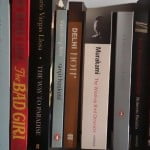
It is the second night of #AWP16. The conference hotel near the Staples Center in Los Angeles, JW Marriott, is packed with people, many of whom are slowly making their way to the bar in the lobby. Soon, there is no room to sit.
The volume gradually increases until I can’t hear anyone speak. From the floor above, the scene looks a bit surreal. Sheer curtains hang down from the roof like shafts of light. The colours change from fuschia to pale blue to violet. In the changing light, the people, all with drinks in their hands, look like ghosts.
I continue to stand there, looking down, still thinking of the powerful keynote address delivered a short while ago by poet Claudia Rankine where she urged the audience to think carefully about ways in which they might be perpetuating white privilege in the literary community. It is nearly eleven, and the bar is just beginning to come alive, but I have a panel at nine the next morning, and after two days here I am already exhausted. I am ready to go to bed.
The scene is electric, quite literally, but it’s not for me. Not any more. Instead, I am already thinking of the panels and readings I hope to attend the next day. For a fleeting moment, before I turn away, however, as the light suddenly changes to crimson, I recall my first AWP and how my grad school friends and I partied into the late hours and I feel a tinge of nostalgia.
The next morning, I join scattered groups of people standing at the cross light. Everyone is carrying identical cream tote bags and wearing their name tags around their necks. If you look real close, many of them have dark circles under their eyes. Some suppress a yawn. The rest take long sips from their Starbucks cups.
From twenty-something hipsters sporting leggings and streaked hair to older folks dressed in dark, plain clothes with grey hair, the convention center, nearby hotels, and all restaurants and cafes in the area have been taken over by these people whose conversations are sprinkled with references to Jonathan Franzen, Greywolf, John D’Agata, and The Paris Review. Pretentious? A little. Inebriated? Mostly. Literary? Absolutely.
What IS the AWP?
Every year, some time between February and April, thousands of aspiring, emerging and established writers descend upon a city in North America to attend the annual conference hosted by the Association of Writers and Writing Programs (AWP). AWP’s first conference was held in 1973 at the Library of Congress and hosted six events and sixteen presenters. The conference grew steadily, adding a bookfair in the mid-eighties.
With more than 2,200 presenters, 12,000 attendees, 550 events, and 700 bookfair exhibitors, AWP’s is now the largest literary conference in the continent. For four days, people ranging in age from their mid-twenties to their sixties and beyond walk around the downtown convention center and surrounding hotels and streets in a daze, trying to navigate hundreds of panels on a variety of topics, social events, readings by authors, a large bookfair, and obligatory networking. Every year, we sigh and moan about how exhausting and overwhelming and superficial it all is, and every year, we go back for more.
AWP is different things for different people. For grad students, who seem to increasingly dominate the scene, the annual pilgrimage is like a vacation, a chance to indulge in the notorious hedonism of AWP – binge-drinking, hanging out at bars until the wee hours, hooking up with strangers, and participating in what is often perceived to be a writer’s typical life in the popular imagination.
Last year, keynote speaker and fiction writer Karen Russell began her address in Minneapolis with the line: “I was told a large number of people here would be hung over or actually drunk.” Naturally, this opening remark met with much self-congratulatory applause and laughter. After all, part of the fun of being a writer is being able to perpetuate myths about how bohemian our lives are, and nowhere is this myth more enduring than at AWP.
What to expect
But all myths have an unpleasant habit of clashing with reality. So what exactly happens at AWP? Like other academic conferences, it comprises hundreds of panels. The process of selecting panels is highly competitive. For the 2016 conference, AWP claims to have received 1,760 proposals, of which they accepted 560, or 32 per cent.
Panels range in subject from creative writing pedagogy to craft in various genres, themed readings, translations, tributes to specific authors, children’s literature, and professional development. Some of the interesting panels I have attended over the years discussed the literary genius of hip hop artist Kendrick Lamar, the cover art of literary journals, how to combine poetry and comics, women and the US/Mexico border, translating contemporary Native American poetry, Agha Shahid Ali and the ghazal.
AWP has faced its share of controversy. Last year, it was charged by critics of not supporting diversity at the conference. Perhaps as a response, several panels this year emphasised the importance of being more inclusive at all levels of the literary community.
Apart from the daylong panels, the conference features marquee readings by renowned writers, as well as a keynote address, which, over the years, has been delivered by the likes of Michael Chabon, Margaret Atwood, Seamus Heaney, and Jhumpa Lahiri. I remember seeing Heaney walk casually down the hallway of my hotel one time, unnoticed by conference attendees around us. While for many AWP might be an opportunity for famous author sightings, the truth is that after three days of drinking and schmoozing, once the AWP haze sets in, most people would have a hard time recognising their own mothers.
Other attractions
For many attendees the most exciting part is the book fair. Weaving your way through aisle after aisle of booths is the perfect way to pick up some free swag in the form of colorful buttons, bookmarks, tote bags or chocolate, as well as to run into lost long acquaintances. There may not be time for more than a fleeting hug or hello but the aimless wandering of fellow readers and writers can be a strangely comforting sight.
It is in the book fair that prestigious journals like Tin House andVirginia Quarterly Review rub spines with more obscure or new magazines. Indie presses like Greywolf share the same space as mainstream houses like Penguin/Random House. From heavily discounted subscriptions to five dollar paperbacks, this is the place to browse and snap up excellent deals. First-time visitors are advised to save sufficient room in their luggage to bring back their new stock.
Outside of the convention center, there are several offsite events at various venues like local bars, bookstores, and restaurants, that go late into the night. These typically include readings organized by different presses, book signings, and receptions by creative writing departments, alumni associations, and literary journals. It is often here, after dark, that the drinking and schmoozing begins.
If you were to ask most regulars to describe their experience in one word, they would say overwhelmed. Rushing from panel to panel, walking across the sprawling bookfair, trying to catch up with numerous old friends and keep appointments with editors and agents before heading to a party is not easy. After attending three panels back to back on the first day, you can find yourself burned out and in need of some down time. Add to this the inevitably superficial nature of many encounters, the endless posturing by hipsters trying to seem cool and intellectual at the same time, and the thirty-five events that have suddenly cropped up on your Facebook page, and suddenly the peace and quiet of your hotel room can appear very appealing.
Experience has taught me that it is simply impossible to attend every event I am invited to, meet up with every person I know from social media, go to every panel that sounds interesting, and even buy every journal that’s sold at half price on the last day. Sometimes, it’s just nice to get away from the crowds to see the sights or try a new restaurant.
Some of my fondest memories of AWPs past are of gathering a few friends and going off to eat elk burger in Denver’s 16th Street Mall, watch The Crucible at the Guthrie Theatre in Minneapolis, stroll around Central Park in New York, browse a bookstore in Harvard Square in Boston, and sample fried grasshoppers in an Oaxacan restaurant in LA. If it were not for these local adventures, it might have been hard to keep each year straight as the conferences start to blend together.
Forget the deals
It is important to note that AWP is not a venue to secure book deals or find agents. If those things happen they are rare. Attending the conference is unlikely to transform anyone’s career. In fact, the time – and energy – can perhaps be better spent holed up somewhere working on a book.
It is by no means a necessary experience. I know many wonderful writers who attend rarely, if ever. And yet, there are those weird moments meant to celebrate the throng of writers who have arrived like locusts – like when the hotel elevator starts to play piped poetry instead of music, or the hotel key is really an ad for an MFA program.
Or the moment when the driver of the shuttle shakes his head in confusion and says: “There are twelve thousand writers headed to the airport. What are we gonna do?” Or that one when you spot a large sign outside a French bistro that reads: Writers Welcome.
It is in those moments that everyone – famous writer and wide-eyed newbie, university professor and stay-at-home mom working on her first manuscript, hipster and curmudgeon – feels at least momentarily united. It may be an illusion, but it’s part of the AWP haze and there’s really no other haze quite like it.
Oindrila Mukherjee is a writer and an Assistant Professor at Grand Valley State University in Grand Rapids, Michigan. You can follow her on Twitter here.
[“source-Scroll”]




